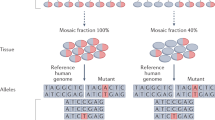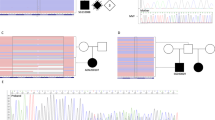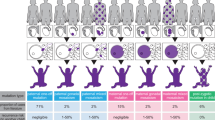Abstract
Trichorhinophalangeal syndrome type I (TRPSI) is a genetic disorder characterized by sparse hair, a bulbous nasal tip, short stature with severe generalized shortening of all phalanges, metacarpal and metatarsal bones and cone-shaped epiphyses. This syndrome is caused by autosomal dominant mutations in the TRPS1 gene. However, because recurrence has been observed in siblings from healthy parents, an autosomal recessive mode of inheritance has also been suggested. We report on a male patient, born to healthy unrelated parents, with TRPSI. Using Sanger sequencing, we identified a mutation in the TRPS1 gene (c.2735 G>A, P.Cys912Tyr). The same mutation was detected as a 10% mosaic mutation by Pyrosequencing in blood-derived DNA from his healthy mother. To our knowledge, this is the first time that somatic mosaicism has been identified in TRPSI. This data combined with the observations of recurrences in siblings from healthy parents modifies the genetic counseling for TRPSI, which should discuss a 5–10 percent recurrence risk for healthy parents with an affected child because of the possibility of germinal mosaicism.
Similar content being viewed by others
Log in or create a free account to read this content
Gain free access to this article, as well as selected content from this journal and more on nature.com
or
References
Klingmuller G : Uber eignetumliche Konstitutions-anomalien der zwei Schwestern und ihre Beziehungen zu neueren entwicklungspathologischenBefunden. Hautarzt 1956; 7: 105–113.
Giedon A : Das tricho-rhino-phalangeal syndrome. Helv Paediatr Acta 1966; 21: 475–482.
Giedon A : Cone-shaped epiphyses of the hands and their diagnostic value. The ticho-rhino-phalangeal syndrome. Ann Radiol 1967; 10: 322–329.
Niikawa N, Kamei T : The Sugio-Kajii syndrome, proposed tricho-rhino-phalangeal syndrome type III. Am J Med Genet 1986; 24: 759–760.
Momeni P, Glockner G, Schmidt O et al: Mutations in a new gene, encoding a zinc-finger protein, cause tricho-rhino-phalangeal syndrome type I. Nat Genet 2000; 24: 71–74.
Napierala D, Sam K, Morello R et al: Uncoupling of chondrocyte differentiation and perichondrial mineralization underlies the skeletal dysplasia in tricho-rhino-phalangeal syndrome. Hum Mol Genet 2008; 17: 2244–2254.
Van der Werff ten Bosch JJ : The syndrome of brachymetacarpal dwarfism (‘pseudo-pseudo-hypoparathyroidism’) with and without gonadal dysgenesis. Lancet 1959; 1: 69–71, cases 5 and 8.
Hussels IE : Trichorhinophalangeal syndrome in two sibs. Birth Defects Orig Artic Ser 1971; 7: 301–303.
Vora NS, Shah S, Dave JN et al: Trichorhinophalangeal syndrome type I. Indian J Dermatol Venereol Leprol 1995; 61: 111–112.
Hilton MJ, Sawyer JM, Gutierrez L et al: Analysis of novel and recurrent mutations responsible for the tricho-rhino-phalangeal syndromes. J Hum Genet 2002; 47: 103–106.
Howell CJ, Wynne-Davies R : The tricho-rhino-phalangeal syndrome: a report of 14 cases in 7 kindreds. J Bone Joint Surg Br 1986; 68: 311–314.
Ludecke HJ, Schaper J, Meinecke P et al: Genotypic and phenotypic spectrum in tricho-rhino-phalangeal syndrome type I and III. Am J Hum Genet 2001; 68: 81–91.
Chen LH, Ning CC, Chao SC : Mutations in TRPS1 gene in trichorhinophalangeal syndrome type I in Asian patients. Br J Dermatol 2010; 163: 416–419.
Beals RK : Tricho-rhino-phalangeal dysplasia: report of a kindred. J Bone Joint Surg Am 1973; 55A: 821–826.
Besser F, Wells RS : The tricho-rhino-phalangeal syndrome (a family with three affected members). Br J Dermatol 95, 1976; (suppl 14): 39–41.
Felman AH, Frias JL : The tricho-rhino-phalangeal syndrome: study of 16 patients in one family. AJR Am J Roentgenol 1977; 129: 631–638.
Ferrandez A, Remirez J, Saenz P et al: The tricho-rhino-phalangeal syndrome: report of 4 familial cases belonging to 4 generations. Helv Paediatr Acta 1980; 35: 559–567.
Giedion A, Burdea M, Fruchter Z et al: Autosomal dominant transmission of the tricho-rhino-phalangeal syndrome: report of 4 unrelated families, review of 60 cases. Helv Paediatr Acta 1973; 28: 249–259.
Erickson RP : Somatic gene mutation and human disease other than cancer: an update. Mutat Res 2010; 705: 96–106.
Zlotogora J : Germ line mosaicism. Hum Genet 1998; 102: 381–386.
Acknowledgements
We thank the patient and his family.
Author information
Authors and Affiliations
Corresponding author
Ethics declarations
Competing interests
The authors declare no conflict of interest.
Rights and permissions
About this article
Cite this article
Corsini, C., Gencik, M., Willems, M. et al. Somatic mosaicism in trichorhinophalangeal syndrome: a lesson for genetic counseling. Eur J Hum Genet 22, 136–139 (2014). https://doi.org/10.1038/ejhg.2013.56
Received:
Revised:
Accepted:
Published:
Issue date:
DOI: https://doi.org/10.1038/ejhg.2013.56
Keywords
This article is cited by
-
A novel TRPS1 mutation in a Moroccan family with Tricho-rhino-phalangeal syndrome type III: case report
BMC Medical Genetics (2017)



